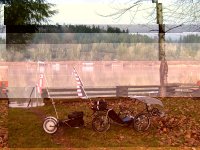I'm finally getting started documenting my electric pusher trailer build. I'm doing this for a thesis project for a design degree. I want to promote the vast amount of information and expertise that are on DIY forums like this one.
Since this is for a design project, I am not just building something that I will be able to use, but want a product with production potential that anyone, with experience or not, can use. I need to design a product for a user with less technical knowledge and tools than you guys here. I am thinking that it needs to be like an accessory that did not significantly change the bike itself. Something that will come off of the bike when you want to ride it yourself. For instance, on a mountain bike you don't necessarily want a 10lb motor unsprung in the front wheel when you are out popping roots. On a road bike, you may want the assistance for a commute to work, but then remove it for some exercise or training on the weekends.
The result of this narrowing of focus leads me to an electric pusher trailer. Pusher trailers have been around for a long time as a concept, and there are an amazing number, variety, and quality of builds on this site. However, there are few electric trailers on the market. They have never really caught on, and I think this is due to a focus on the die-hard cyclist, and not the general public that own an underutilized bike.
As far as geometry, I have seen some that attach to the seat post, but this may not be the best geometry. The closer the connection of the trailer is to the contact patch of the rear wheel, the less disturbing the mass is to deal with. There are a couple of trailers I've seen that attached to the lugs on both sides, but they were long cargo trailers. This would make city/campus/parking more difficult. I am leaning toward an extrawheel trailer. I am going to combine the lug mounted style with a hub motor to take advantage of the dynamics, and short length, and simple implementation.
Since this is for a design project, I am not just building something that I will be able to use, but want a product with production potential that anyone, with experience or not, can use. I need to design a product for a user with less technical knowledge and tools than you guys here. I am thinking that it needs to be like an accessory that did not significantly change the bike itself. Something that will come off of the bike when you want to ride it yourself. For instance, on a mountain bike you don't necessarily want a 10lb motor unsprung in the front wheel when you are out popping roots. On a road bike, you may want the assistance for a commute to work, but then remove it for some exercise or training on the weekends.
The result of this narrowing of focus leads me to an electric pusher trailer. Pusher trailers have been around for a long time as a concept, and there are an amazing number, variety, and quality of builds on this site. However, there are few electric trailers on the market. They have never really caught on, and I think this is due to a focus on the die-hard cyclist, and not the general public that own an underutilized bike.
As far as geometry, I have seen some that attach to the seat post, but this may not be the best geometry. The closer the connection of the trailer is to the contact patch of the rear wheel, the less disturbing the mass is to deal with. There are a couple of trailers I've seen that attached to the lugs on both sides, but they were long cargo trailers. This would make city/campus/parking more difficult. I am leaning toward an extrawheel trailer. I am going to combine the lug mounted style with a hub motor to take advantage of the dynamics, and short length, and simple implementation.






















